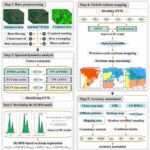
Alzheimer’s disease (AD) continues to pose one of the greatest challenges in modern medicine, impacting millions worldwide with progressive cognitive decline and behavioral impairment. Despite decades of research, effective treatment strategies remain elusive, emphasizing the immense value of early and accurate diagnosis. In this groundbreaking new study, researchers have harnessed advanced signal processing techniques applied to electroencephalography (EEG) data to distinguish between individuals suffering from AD, mild cognitive impairment (MCI), and healthy controls. This innovative approach could redefine how cognitive disorders are detected, potentially revolutionizing diagnostics in neurology.
Unlike traditional diagnostic methods that often rely on clinical evaluation or costly neuroimaging, the novel methodology exploits the subtle, intrinsic patterns hidden within the brain’s electrical activity. EEG, a non-invasive and relatively accessible modality, records neuronal oscillations that can reveal profound insights into brain function and dysfunction. Yet, EEG signals are inherently non-stationary and complex, requiring sophisticated algorithms to extract meaningful information. The study in question addresses these challenges by implementing two nonlinear mathematical techniques—Poincare and Entropy analyses—to uncover features that effectively discriminate among AD, MCI, and healthy individuals.
The Poincare method, rooted in nonlinear dynamics, provides a geometrical representation that captures variability and timing irregularities in physiological signals. When applied to EEG data, this technique offers a nuanced lens to observe the brain’s rhythmic fluctuations and adaptability. Complementing this, Entropy-based measures quantify the complexity and unpredictability of the EEG signals, yielding metrics that reflect the underlying neural informational richness or degradation. Together, these methodologies capture diverse facets of the EEG time series, presenting a comprehensive portrait of neural activity alterations associated with cognitive impairment.
A key strength of the study lies in its recognition of EEG’s non-stationary nature, which implies that the statistical properties of EEG signals change over time. To accommodate this, the researchers divided continuous EEG recordings into multiple short epochs, enabling detailed temporal analysis and feature extraction within these intervals. This epoch-based segmentation enhances the sensitivity of the derived features, providing machine learning algorithms with more robust and representative data inputs for classification purposes.
Once features were extracted, the data were fed into carefully selected machine learning classifiers trained to differentiate between Alzheimer’s disease, mild cognitive impairment, and cognitively healthy subjects. Machine learning offers a powerful framework to analyze complex, multidimensional datasets and identify patterns that may elude traditional statistical analyses. Through extensive experimental evaluation, the study verified that the combined use of Poincare and Entropy-derived features significantly improved classification performance, surpassing that of previous EEG-based diagnostic approaches.
Specifically, the researchers reported notable gains across key performance metrics, including accuracy, sensitivity, and specificity. Accuracy refers to the method’s overall ability to correctly identify individuals’ cognitive status, while sensitivity and specificity measure its proficiency in correctly detecting those with and without impairment, respectively. High sensitivity is particularly crucial in clinical screenings to minimize missed diagnoses, whereas high specificity reduces false positives that can cause undue anxiety and unnecessary follow-up procedures.
The implications of this research are profound. Early detection of Alzheimer’s and its precursor stages like MCI enables timely intervention, potentially slowing disease progression and maintaining quality of life. Additionally, the accessibility and cost-effectiveness of EEG-based diagnostics make this approach scalable for broader population screening, including in resource-limited settings where advanced neuroimaging is not feasible. The use of advanced nonlinear signal processing and machine learning collectively represents an emergent paradigm in neurodiagnostics, moving beyond surface-level analyses toward a mechanistic understanding of brain pathophysiology.
Critically, this study also opens new avenues for personalized medicine. By identifying subtle electrophysiological biomarkers unique to individual cognitive status, clinicians could monitor disease progression dynamically and tailor therapeutic strategies accordingly. Furthermore, the methodology’s adaptability suggests potential application to other neurological conditions characterized by disrupted brain rhythms, such as Parkinson’s disease or epilepsy, expanding its clinical relevance.
While promising, the research team acknowledges that further validation in larger, diverse populations is necessary to ensure broad applicability and reliability. Longitudinal studies could assess the predictive power of these EEG features over time, determining how early alterations manifest before clinical symptoms emerge. Integration with other biomarkers, such as neuropsychological tests or genetic information, could also enhance overall diagnostic accuracy.
Nevertheless, this pioneering work exemplifies how integrating cutting-edge mathematical methods with neuroscientific data can yield transformative healthcare solutions. As the global burden of neurodegenerative diseases escalates, innovations like these provide hope for more effective disease management through precision diagnostics. The convergence of biomedical engineering, data science, and neurology heralds a new era where invisible brain signals can be decoded to reveal vital truths about cognitive health.
In summary, by leveraging Poincare and Entropy analyses of EEG signals combined with machine learning, the researchers have established a powerful, non-invasive tool for differentiating Alzheimer’s, mild cognitive impairment, and healthy cognition with unprecedented accuracy. This breakthrough underscores the potential of nonlinear dynamics and complexity science to unlock the brain’s elusive signatures, paving the way for earlier interventions and improved patient outcomes in dementia care.
—
Subject of Research: Detection and classification of Alzheimer’s disease, mild cognitive impairment, and healthy cognition using nonlinear analysis of EEG signals.
Article Title: Detection of Alzheimer and mild cognitive impairment patients by Poincare and Entropy methods based on electroencephalography signals
Article References: Aslan, U., Akşahin, M.F. Detection of Alzheimer and mild cognitive impairment patients by Poincare and Entropy methods based on electroencephalography signals. BioMed Eng OnLine 24, 47 (2025). https://doi.org/10.1186/s12938-025-01369-6
Image Credits: AI Generated
DOI: https://doi.org/10.1186/s12938-025-01369-6
Tags: advanced signal processing in neurologyAlzheimer’s disease detectionbrain electrical activity patternscognitive decline diagnosisearly detection of Alzheimer’sEEG Poincare entropy analysiselectroencephalography in cognitive healthinnovative diagnostic methodologiesmild cognitive impairment identificationneurological disorder diagnosticsnon-invasive EEG techniquesnonlinear dynamics in EEG


